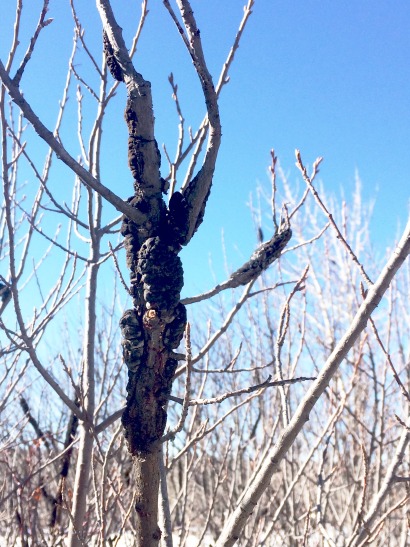Black Knot won’t kill your tree but, if left long enough, it will make you want to.
(Photo credit: “Black Knot disease on Cherry, caused by Apiosporina morbosa" by Robert L. Anderson, USDA Forest Service, licensed under CC BY 3.0.)
Black Knot won’t kill your tree but, if left long enough, it will make you want to. If allowed to set up, the knots will proliferate to number in the hundreds. The pruning job required to remove them all would leave your once beautiful tree looking severely truncated, not a tree at all.
Always present and seemingly under control in the native chokecherry, Black Knot’s most common host is the Mayday tree. The purple-leaved Schubert chokecherry is also susceptible, although to a lesser degree.
What is it?
Black Knot is a fungus, Apiosporina morbosa to my pathologist friend. Like all fungi, it takes its energy from other living and dead things. Once mature, it produces spores and it is when one of these invisible little hooks lands on your tree that the trouble begins.
During the first year, you won’t see anything as the fungal structure gets a good hold inside a branch. After infection in the spring, the immature swollen knots usually appear in the fall. They are then dormant as they pass through the winter. Next spring, they resume growth, getting longer and thicker. Then the bark will split and the classic Black Knot becomes visible. The mature spores on the surface of the knot are released in great number the next spring, completing the cycle.
Treatment
There is no cure for Black Knot, other than regular inspection followed by pruning.
Working with this fungus through the years, I have made some interesting observations. Most of the Black Knot in Calgary has a physical limit to its growth capabilities. While completely wrapping around and killing smaller branches, when the fungus sets up on the trunk of a tree, it usually can’t reach all the way around. In this case, liquid transport has not been interrupted and the branches above are full of healthy leaves. When I find one of these, I turn my saw on the knot itself, shaving away at it. I try never to harm the margins where the knot meets the uninfected tissue. Sometimes this has good results.
(Photo credit: “Black Knot disease on Cherry, caused by Apiosporina morbosa" by Robert L. Anderson, USDA Forest Service, licensed under CC BY 3.0.)









